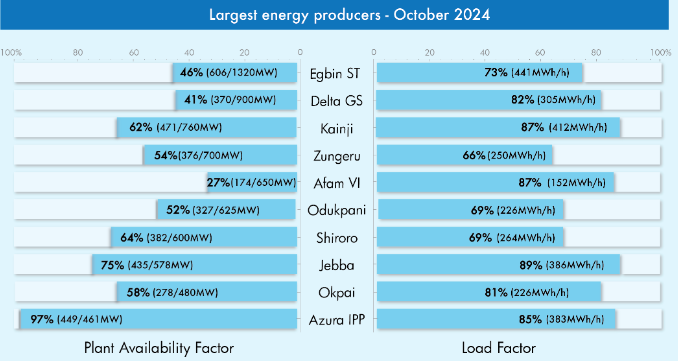A recent factsheet from the Nigerian Electricity Regulatory Commission (NERC) reveals that Azura IPP performed best of all energy producers in October 2024. The data sheds light on the performance of Nigeria’s largest power plants for October 2024.
Using two critical metrics, the Plant Availability Factor and Load Factor, the data highlights the extent to which these plants contributed to the national grid.
Plant Availability Factor
The Plant Availability Factor is an indicator of how consistently each plant was able to generate power. It measures the percentage of time a plant was operational compared to its total capacity. The findings reveal substantial variability among Nigeria’s power stations.
Leading the list is Azura Independent Power Plant (IPP) with an impressive availability factor of 97%, meaning it was able to provide power almost continuously, generating 449 MW out of its 461 MW capacity. This high availability factor underscores Azura IPP’s reliability as a critical player in Nigeria’s energy mix.
Conversely, Afam VI struggled with a low availability factor of 27%, producing only 174 MW out of a possible 650 MW. Other major plants, like Egbin ST and Delta GS, also had relatively low availability factors at 46% and 41%, respectively, indicating that over half of their potential capacity was unutilized. This underperformance can be attributed to issues such as aging infrastructure, maintenance challenges, and occasional fuel shortages.
In the mid-range, Jebba and Shiroro fared reasonably well with availability factors of 75% and 64%, respectively. These hydroelectric plants demonstrate better operational efficiency, suggesting that hydropower may play a more stable role in Nigeria’s energy sector if harnessed further.
Load Factor
The Load Factor reflects how much of the plant’s potential output is being utilized on average. In this regard, Kainji and Afam VI performed the best, each achieving a load factor of 87%, showing their strong operational efficiency in converting available power into actual output.
Jebba, another hydroelectric plant, recorded a load factor of 89%, producing 386 MWh/h, which indicates a high level of performance and reliability. Similarly, Azura IPP had a load factor of 85%, further establishing it as one of the most dependable power producers in the country.
Egbin ST, one of Nigeria’s largest plants by capacity, had a load factor of 73%, reflecting significant room for improvement in its utilization of available power. Okpai and Delta GS also performed reasonably well with load factors of 81% and 82%, respectively.

What to note
- While some power plants like Azura IPP and Jebba are operating with high efficiency and reliability, others like Afam VI and Egbin ST face substantial operational challenges.
- Addressing these disparities will be essential for stabilizing Nigeria’s electricity supply and ensuring a more reliable energy future.
- Improving the availability and load factors across all plants is crucial, as it would enable the sector to meet rising demands and reduce the frequent blackouts that have long plagued the country.
- The data underscores a need for targeted investments, especially in maintenance and upgrades, to enhance the performance of Nigeria’s power infrastructure.